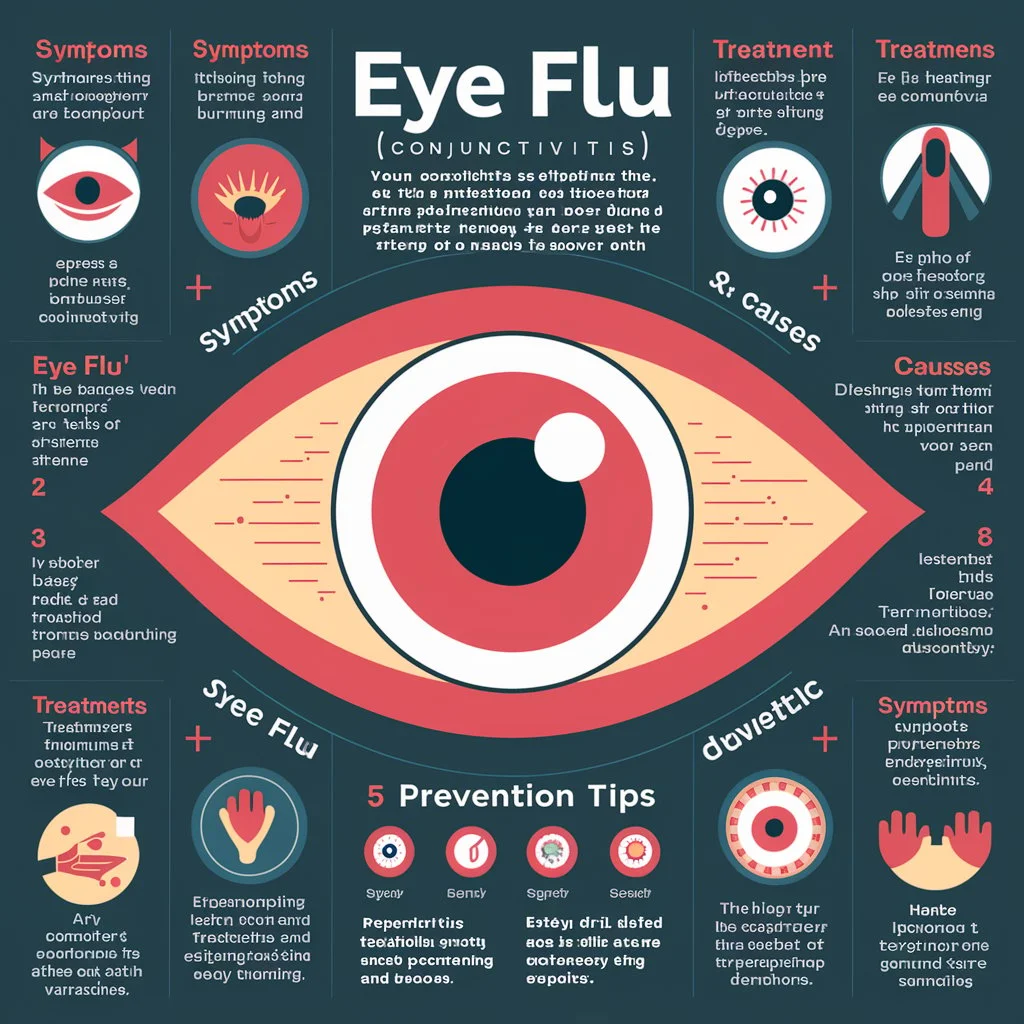Learn about eye flu symptoms, causes, and effective treatments to keep your eyes healthy. Discover prevention tips and home remedies for conjunctivitis.
Eye flu, or conjunctivitis, is an infection that causes inflammation of the conjunctiva, the thin layer covering the white part of the eye and the inside of the eyelids. This condition can make your eyes look red and feel very uncomfortable. There are different types of eye flu, including viral, bacterial, and allergic conjunctivitis.
How Does Eye Flu Spread?
Eye flu is highly contagious and can easily spread from one person to another. It is often transmitted through:
- Direct contact with infected individuals
- Touching your eyes with contaminated hands
- Sharing personal items like towels or makeup
Types of Eye Infections
There are three main types of eye infections:
- Viral Conjunctivitis: Caused by viruses like the adenovirus, it often accompanies a cold or respiratory infection.
- Bacterial Conjunctivitis: Resulting from bacteria such as Staphylococcus aureus, it can cause more severe symptoms and requires antibiotics.
- Allergic Conjunctivitis: Triggered by allergens like pollen, dust, or pet dander, this type is not contagious.
Understanding these types helps in identifying the appropriate treatment and preventive measures.
Eye Flu Symptoms
Recognizing Eye Flu Symptoms
Eye flu symptoms can vary depending on the type of infection but generally include:
- Redness: Your eyes may appear bloodshot.
- Itchiness: A persistent urge to rub your eyes.
- Watery Eyes: Excessive tearing or discharge.
- Discharge: A sticky or watery substance, often more noticeable upon waking.
- Swelling: Puffiness around the eyes.
Differentiating Eye Flu from Other Conditions

It’s important to distinguish eye flu from other eye issues such as:
- Allergies: Usually accompanied by sneezing and nasal congestion.
- Dry Eyes: Typically caused by prolonged screen time or environmental factors.
- Bacterial Infections: Often present with more intense symptoms and pus-like discharge.
Symptoms in Detail
- Redness and Irritation: Caused by the body’s immune response to infection.
- Discharge Types: Viral conjunctivitis usually has a watery discharge, while bacterial causes a thicker, yellowish one.
- Swelling and Pain: More common in severe cases, especially bacterial conjunctivitis.
Understanding these symptoms can help in early identification and timely treatment.
Causes of Eye Flu
Common Causes of Viral Eye Infections
Viral conjunctivitis is often linked to common viruses such as:
- Adenovirus: The most frequent cause, often associated with respiratory infections.
- Herpes Simplex Virus: Can cause more severe symptoms and requires specific antiviral treatment.
How Eye Flu is Transmitted
Eye flu spreads through:
- Direct Contact: Shaking hands with an infected person or touching contaminated surfaces.
- Indirect Contact: Using shared items like towels, makeup, or pillows.
Risk Factors and Vulnerable Groups

Certain groups are more susceptible to eye flu:
- Children: Due to their close contact in schools and playgrounds.
- Immunocompromised Individuals: Those with weakened immune systems are at higher risk.
- Contact Lens Users: Improper lens hygiene can lead to infections.
Understanding these causes and risk factors can help in taking preventive measures.
Diagnosis of Eye Flu
How to Diagnose Eye Flu?
Diagnosing eye flu involves:
- Clinical Examination: Doctors look for characteristic signs like redness, discharge, and swelling.
- Patient History: Information about recent contacts and symptoms.
- Laboratory Tests: Swabs of the discharge may be taken for further analysis.
When to See a Doctor?
It’s crucial to seek medical advice if you experience:
- Severe Pain: Persistent or worsening pain in the eyes.
- Vision Changes: Blurred vision or sensitivity to light.
- Persistent Symptoms: Symptoms lasting more than a week despite home care.
Diagnostic Tests and Procedures

Common tests include:
- Slit Lamp Examination: Provides a detailed view of the eye structures.
- Conjunctival Swab: Helps identify the specific pathogen causing the infection.
Early diagnosis ensures appropriate treatment and prevents complications.
Eye Flu Treatment
Medical Treatments for Eye Flu
Treatment varies based on the type of conjunctivitis:
- Antiviral Medications: For viral infections caused by herpes simplex.
- Antibiotics: For bacterial conjunctivitis to eliminate the bacteria.
- Antihistamines: For allergic conjunctivitis to reduce symptoms.
Home Remedies for Eye Flu
Simple home remedies can provide relief:
- Warm Compress: Helps soothe irritation and reduce swelling.
- Cold Compress: Relieves itching and discomfort.
- Good Hygiene: Regular hand washing and avoiding eye contact.
Importance of Following Prescribed Treatment

Adhering to the treatment plan is crucial for recovery:
- Complete the Full Course: Even if symptoms improve, finish all medications.
- Avoid Self-Medication: Only use prescribed eye drops and ointments.
Effective treatment minimizes the risk of complications and speeds up recovery.
Preventing Eye Flu
Tips for Preventing the Spread of Eye Flu
Preventive measures are essential to stop the spread:
- Hand Hygiene: Regularly wash hands with soap and water.
- Avoid Touching Eyes: Minimize hand-to-eye contact.
- Personal Items: Do not share towels, makeup, or pillows.
Preventative Measures for Families
Keeping your family safe involves:
- Educating Children: Teach them about hygiene and not sharing personal items.
- Regular Cleaning: Disinfect commonly touched surfaces in your home.
Role of Vaccination

Vaccines may help prevent certain viral infections that cause conjunctivitis:
- Flu Vaccine: Reduces the risk of respiratory infections that can lead to eye flu.
Taking these preventive steps helps protect you and your loved ones from eye flu.
Eye Flu in Children
Special Considerations for Eye Flu in Children
Children are particularly vulnerable to eye flu due to their close interactions:
- Symptoms in Children: Similar to adults but may include more pronounced discomfort.
- Treatment and Care: Ensuring proper hygiene and administering prescribed medications.
Preventing the Spread in Schools and Daycare Centers
Schools and daycares can be hotspots for eye flu transmission:
- Hygiene Education: Teach kids to wash hands and avoid touching their eyes.
- Disinfection: Regularly clean toys, surfaces, and common areas.
Addressing Parents’ Concerns
Parents need to be vigilant:
- Monitor Symptoms: Keep an eye on your child’s symptoms and seek medical advice if needed.
- Communicate with Schools: Inform schools about your child’s condition to prevent outbreaks.
By focusing on these areas, you can help protect children from eye flu and ensure a quick recovery if they do get infected.
Recovery and Aftercare
Expected Recovery Time for Eye Flu
Recovery time varies:
- Viral Conjunctivitis: Typically resolves within 1-2 weeks.
- Bacterial Conjunctivitis: Usually improves within a week with antibiotics.
- Allergic Conjunctivitis: Persists as long as the allergen is present.
Caring for Eyes During Recovery
Proper care during recovery includes:
- Avoiding Contact Lenses: Switch to glasses until fully recovered.
- Maintaining Hygiene: Keep the eye area clean and avoid rubbing your eyes.
Signs of Complications
Watch for signs of complications:
- Persistent Redness: Redness that doesn’t improve may indicate a more serious issue.
- Vision Changes: Blurred vision or increased sensitivity to light should be evaluated by a doctor.
By following these aftercare steps, you can ensure a smooth recovery and prevent further issues.
Eye Flu vs. Other Conditions
How to Differentiate Eye Flu from Other Eye Conditions
Understanding the differences helps in accurate diagnosis:
- Allergies: Often accompanied by sneezing and nasal congestion.
- Bacterial Infections: Typically more severe with pus-like discharge.
- Dry Eye Syndrome: Caused by environmental factors and prolonged screen time.
Importance of Accurate Diagnosis
Accurate diagnosis ensures proper treatment:
- Consult a Doctor: When in doubt, seek professional medical advice.
- Follow Recommendations: Adhere to prescribed treatments and follow-up appointments.
Common Misconceptions
Addressing myths about eye flu:
- Not Always Serious: Many cases are mild and resolve with proper care.
- Contagiousness: Understanding how it spreads can prevent unnecessary fear.
Accurate information helps manage eye flu effectively and reduces anxiety.
FAQs
What are the common symptoms of eye flu?
Common symptoms of eye flu include redness, itchiness, watery eyes, and a sticky discharge. Your eyes might feel uncomfortable and look bloodshot. You may also experience swelling around the eyes. These symptoms can vary depending on the type of eye flu you have.
How does eye flu spread?
Eye flu spreads through direct contact with an infected person or by touching contaminated surfaces. It can also spread by sharing personal items like towels or makeup. Practicing good hand hygiene and avoiding touching your eyes can help prevent its spread.
Can eye flu be treated at home?
Yes, eye flu can be treated at home with simple remedies. Warm compresses can soothe irritation, and good hygiene practices are essential. However, if symptoms are severe or persistent, it’s important to see a doctor. Following medical advice ensures proper treatment.
When should I see a doctor for eye flu?
You should see a doctor if you experience severe pain, vision changes, or symptoms that last more than a week. A doctor can provide the right diagnosis and treatment. Persistent or worsening symptoms need medical attention to prevent complications.
Is eye flu contagious?
Yes, eye flu is very contagious. It can easily spread from person to person through direct contact or by sharing contaminated items. Practicing good hygiene, like washing hands and not sharing personal items, helps prevent spreading it.
How can I prevent getting eye flu?
To prevent eye flu, practice good hand hygiene and avoid touching your eyes. Don’t share personal items like towels, makeup, or contact lenses. Educating family members about these practices also helps keep everyone safe.
What are the different types of eye flu?
The different types of eye flu include viral, bacterial, and allergic conjunctivitis. Viral is caused by viruses and often comes with a cold. Bacterial is more severe and needs antibiotics, while allergic is triggered by allergens like pollen and is not contagious.
How long does it take to recover from eye flu?
Recovery from eye flu usually takes about 1-2 weeks for viral conjunctivitis. Bacterial conjunctivitis typically improves within a week with antibiotics. Allergic conjunctivitis lasts as long as the allergen is present. Proper treatment and care can speed up recovery.
Conclusion
In summary, eye flu is a common but manageable condition. Recognizing the symptoms early, seeking timely treatment, and following preventive measures are key to maintaining eye health. Stay informed, practice good hygiene, and consult a healthcare professional if needed. Keep your eyes healthy and clear!
Additional Resources
- Links to Reputable Sources: CDC, Mayo Clinic, WebMD
- Infographics: Visual aids summarizing key information
- Personal Stories: Testimonials from individuals who have dealt with eye flu
By covering all these aspects, your blog post on eye flu symptoms will provide comprehensive and valuable information to your readers.

I’m Matthew Porter, the creative mind behind “Acknowledgment Templates.” I’ve had a blast creating templates that capture the essence of gratitude in acknowledgment sections. At Acknowledgment Templates, we’re all about turning appreciation into a well-crafted art. Let’s make your acknowledgment section a masterpiece—join me in the creative process at Acknowledgment Templates!




